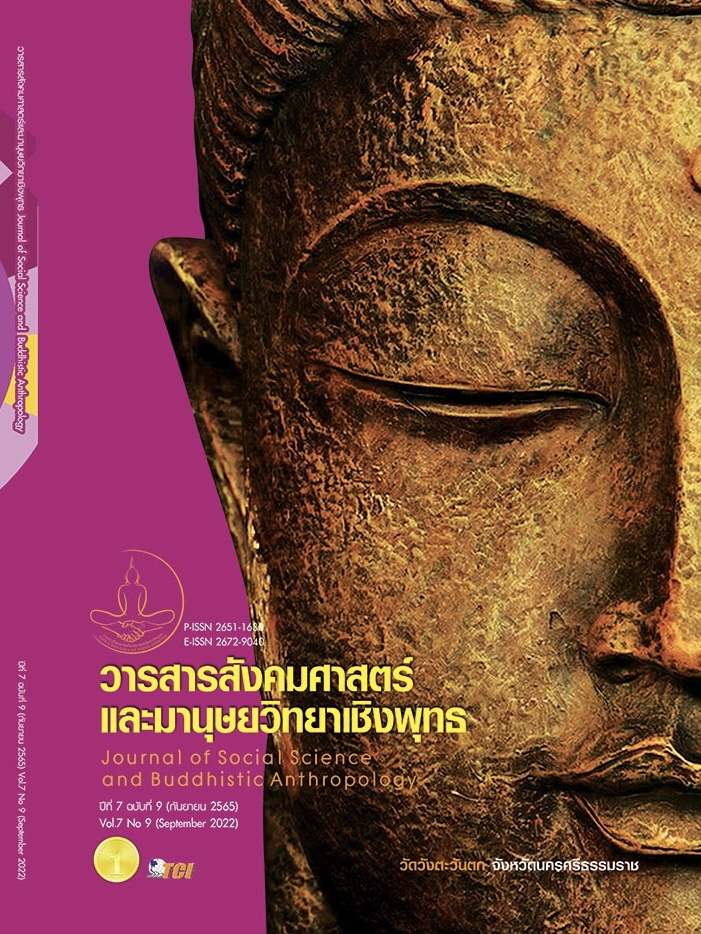THE MODEL OF COMPETENCY DEVELOPMENT FOR TELEVISION NEWS BROADCASTERS IN THAILAND
Keywords:
The Model Development, Competency for Television News Broadcasters, Television News Broadcasters, POUND Model, Television BroadcastingAbstract
The objectives of this research article were to 1) study operating conditions, problems and current obstacles of television news broadcasters for television broadcasting in Thailand, 2) study the competence of television news broadcasters, and 3) present a model for developing the competence of television news broadcasters. The research design was a mixed method. The research was qualitative, using in-depth interview from 12 key informants. Next, a brainstorming group discussion was held to consider the draft model obtained from 7 experts as well as to confirm the pattern with quantitative research. The quantitative research used simple random sampling and selective selection to make questionnaires for collecting data from 400 the sample group. The statistics for analysis data were percentage, mean and standard deviation. The results showed that the competence of television news broadcasters for television broadcasting in Thailand could be divided into 4 areas: core competencies, job-specific competencies, management competence, and other performances. As for the development model of the competency of television news broadcasters for television broadcasting in Thailand being developed was called “POUND Model”. There were five components: 1) provisions consisted of 2 parts: basic core competencies includes knowledge, skills, physical attributes and equilibrium management competence, 2) appropriateness individual core competencies includes knowledge, skills, physical attributes, and internal drives, 3) utilities includes knowledge, skills, and physical attributes, 4) natural characteristics includes internal driving competencies and physical performance, and 5) divertissement individual core competencies consists of skills and physical attributes. Furthermore, there should be a study of the competence of television news broadcasters having dependance on factors and contexts of the audience, time, technology, social-economic conditions and competition in the industry. Also, study tools or methods for developing competency of television news broadcasters should be reviewed to have similar concrete standards as well.
References
ธนิสสรา สุวรรณนันท์. (2552). การคัดเลือกและการพัฒนาผู้ประกาศข่าวของสถานีโทรทัศน์ในประเทศไทย. ใน วิทยานิพนธ์วารสารศาสตรมหาบัณฑิต สาขาวิชาการบริหารสื่อสารมวลชน. มหาวิทยาลัยธรรมศาสตร์.
ธาตรี ใต้ฟ้าพูล. (2557). แนวทางการกำหนดกรอบจริยธรรมและการดำเนินงานในการประกอบกิจการกระจายเสียงและกิจการโทรทัศน์ประเภทบริการสาธารณะ. วารสารการประชาสัมพันธ์และการโฆษณา, 7(2), 1-24.
นิศารัตน์ นาคทั่ง. (2559). รูปแบบการพัฒนาสมรรถนะการสอนภาคปฏิบัติในคลินิกของอาจารย์ใหม่ วิทยาลัยพยาบาลในเขตภาคเหนือ สังกัดสถาบันพระบรมราชชนก. ใน ดุษฎีนิพนธ์ปรัชญาดุษฎีบัณฑิต สาขาการศึกษา. มหาวิทยาลัยนเศวร.
นิสดารก์ เวชยานนท์. (2556). Competency-Based Approach (พิมพ์ครั้งที่ 6). นนทบุรี: เดอะ กราฟิโก ซิสเต็มส์.
นุดี หนูไพโรจน์ และณปิติยา บรรจงจิตร์. (2552). เส้นทางการเป็นผู้ประกาศข่าวโทรทัศน์ไทย. ใน รายงานวิจัย. มหาวิทยาลัยหัวเฉียวเฉลิมพระเกียรติ.
ประคุณ รุ่งธนวิชญ์. (2560). ความท้าทายของทีวีดิจิทัลไทยในยุคการเปลี่ยนแปลงพฤติกรรมในการใช้ประโยชน์จากสื่อโสตทัศน์ของประชาชน. วารสารวิชาการ กสทช, 1(1), 192-214.
พรณรงค์ พงษ์กลาง. (2561). การปรับตัวของผู้ประกอบการโทรทัศน์ ให้อยู่ได้ในยุคทีวีดิจิทัล. วารสารมนุษยศาสตร์และสังคมศาสตร์ มหาวิทยาลัยมหาสารคาม, 37(2), 142-154.
พสุ เดชะรินทร์. (2551). Balanced Scorecard รู้สึกในการปฏิบัติ. กรุงเทพมหานคร: โรงพิมพ์แห่งจุฬาลงกรณ์มหาวิทยาลัย.
ภัทธีรา สารากรบริรักษ์. (2555). ผู้ประกาศและการใช้เสียงทางวิทยุและโทรทัศน์. กรุงเทพมหานคร: สำนักพิมพ์มหาวิทยาลัยธรรมศาสตร์.
รัตนากร ทองสำราญ และสิริรัตน์ นิ่มเงิน. (7 กรกฎาคม 2559). สภาพการดำเนินงานและสมรรถนะผู้ประกาศข่าวโทรทัศน์ภายใต้กฎหมายและการการกำกับดูแลของ กสทช. (รัฐวัชร์ พัฒนจิระรุจน์, ผู้สัมภาษณ์)
ศรัญญ์ทิตา ชนะชัยภูวพัฒน์ และ รัตนา ทิมเมือง. (2562). การศึกษาความหมายเชิงคุณค่าและพัฒนาเกณฑ์ การพิจารณาตัดสินโครงการรางวัลทีวีสีขาว. วารสารนิเทศศาสตรปริทัศน์, 23(2), 114-129.
สนมพร ฉิมเฉลิม. (2542). กระบวนการคัดเลือกผู้ประกาศข่าวโทรทัศน์. ใน วิทยานิพนธ์นิเทศศาสตรมหาบัณฑิต สาขาวิชาการสื่อสารมวลชน. จุฬาลงกรณ์มหาวิทยาลัย.
สมบัติ ลีลาพตะ. (2556). ความรู้ทั่วไปเกี่ยวกับกิจการกระจายเสียงและกิจการโทรทัศน์. ตำราอบรมหลักสูตร ผู้ประกาศในกิจการกระจายเสียงและกิจการโทรทัศน์ ระดับต้น. กรุงเทพมหานคร: ส เจริญ การพิมพ์.
สาธิต เชื้ออยู่นาน. (2560). การวิจัยผสานวิธีแบบการสำรวจเป็นลำดับ: แนวคิดและการประยุกต์ใช้. วารสารวิชาการ Veridian E-Journal, Silpakorn University ฉบับภาษาไทย สาขามนุษยศาสตร์ สังคมศาสตร์ และศิลปะ, 10(1), 1394-1404.
องอาจ สิงห์ลำพอง. (2560). การบริหารจัดการรายการโทรทัศน์ในยุคไทยแลนด์ 4.0. วารสารนิเทศศาสตร์ธุรกิจบัณฑิตย์, 11(2), 209-245.
อาภรณ์ ภู่วิทยพันธุ์. (2553). การจัดทำเส้นทางการฝึกอบรมระยะยาวบนพื้นฐานของขีดความสามารถ Competency-Based Training Road Map. กรุงเทพมหานคร: พิมพ์ดีดการพิมพ์.
Andressa, D. J. et al. (2020). Competências do profissional jornalista naperspectiva da indústria 4.0. Revista de Ciências Da Administração, 22(58), 22-38.
Berlo, D. K.(1960). The Process of Communication. New York: Holt Rinehart & Winston.
Creswell, J. W. & Plano Clark V. L. (2011). Designing and conducting mixedmethods research (2nd ed.). Los Angeles, California: Sage Publication.
Kaplan, R. S. & Norton, D. P. (1996). The Balanced Scorecard: Translating Strategy into Action. Boston: Harvard Business School Press.
MacBride Commission. (1980). Many voice, one world: Towards a new, more justand more efficient world information and communication. Paris: UNESCO.
McKay, D. R. (2019). What does a news anchor do? Learn about thesalary, required skills, & more. The Balance Careers. Retrieved January 31, 2022, from https://www.thebalancecareers.com/news-anchor-526047
McQuail, D. (1994). Mass communication theory: An introduction (3rd ed.). London: Sage.
Nwammuo, A. N. (2022). Broadcast commentary and announcing. National Open University of Nigeria. Retrieved January 31, 2022, from https://nou.edu.ng/ coursewarecontent/MAC444.pdf
Parry, S. B. (1998). The Quest for Competencies. Journal of Training, 33(7), 48-56.
Qabilovna, Y. Z. (2020). The Role of The TV Anchor in The News Program andAuthority He Has Achieved During His
Career. The American Journal of Social Science and Education Innovations, 2020(2), 334-345.
Schena, J. et al. (2018). Updated assessment of the competencies required fromSpanish journalists in the professional workplace. Revista Latina de Comunicación Social, 2018(73), 531-555.
Spencer, L. M. & Spencer, S. M. (1993). Competency at Work: Model for SuperiorPerformance. New York: John Wiley and Sons.
Sumbogo, I. A.& Diposumarto N. S. (2017). Pengaruh kompetensi dan pelatihanterhadap kinerja reporter, dengan motivasi sebagai variabel mediasi di PT swc. Jurnal Riset Manajemen dan Bisnis, 2(3), 331-340.
Yamane, T. (1973). Statistics: An introductory analysis (3rd ed.). New York: Harperand Row.
Downloads
Published
How to Cite
Issue
Section
License

This work is licensed under a Creative Commons Attribution-NonCommercial-NoDerivatives 4.0 International License.








